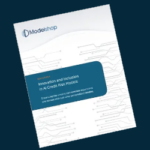As organizations navigate increasing competition and cost pressure, the role of automation has become a key part of most IT roadmaps. It’s become clear that repetitive manual processes not only incur delays and costs, but they can degrade the consistency and security of the business.
The core challenge companies face is that it is not easy, or even desirable, to replace the human intelligence that currently fuels these processes. If you are a dynamic business, your finance, risk, customer service and marketing departments add tremendous value to the company through the decisions they make every day.
It is not easy, or even desirable, to fully replace human intelligence.
Automating that intelligence out of the process would be a disaster for most businesses, so as a result, automation efforts that attempt to ‘capture’ the process and turn it into automated bots will meet tremendous resistance and will ultimately fail.
This doesn’t mean that automation can’t be used to streamline processes for most teams. Any financial analyst would welcome relief from the tedious upload, copy, paste, recalculate, export and email cycle that happens every day for staff doing analytic work with data. Surveys show that an analyst will spend 70% of their time manually manipulating spreadsheets, often while processing repetitive reports or models that require little new analysis. Their time is more valuable than that. It is possible with the right automation tools to streamline the low-value parts of these processes while still allowing experts to participate in critical decisions and interactively adjust their automations on the fly.
This need for analytic agility is the source of some of the friction experienced by automation efforts. IT organizations are designed to run centrally and support business units through focused projects. These projects have schedules, budgets, documented requirements and an end date.
For analytic teams, automation isn’t a project, it’s a discipline.
The reality is that for analytic teams, automation isn’t a project, it is a discipline for how they use technology to do their jobs better. When embedded in a department’s best practices, intelligent automation tools will be used as often as tools like Excel and Word are today. New automation projects should take hours, not months, and tweaks to existing automation should take minutes or seconds. Deploying an automation solution that is any less agile or self-serve then the tools analytic teams use today will significantly under-perform the current process, and will be rejected as a result.
This basic shift in intelligent automation’s focus from centralized projects to departmental discipline will begin to take hold as the first wave of automation projects struggle to deliver the benefits they promise. A new generation of intelligent automation solutions are emerging that have the computational power to replace spreadsheets and can be configured by business experts but also provide the corporate level security and audit trail controls organizations demand.
A new generation of automation tools will replace spreadsheets as the ubiquitous analytic tool.
As teams experience the benefits of automation without losing their business agility, productivity and innovation will soar. Imagine your finance, product and sales teams collaborating on a new strategy while they share data, analytic applications and APIs that they’re able to create on the fly. This new generation of automation will replace the spreadsheet as the ubiquitous data and analysis sharing tool, giving way to a new generation of collaboration, agility and efficiency that is the true promise of intelligent automation.






